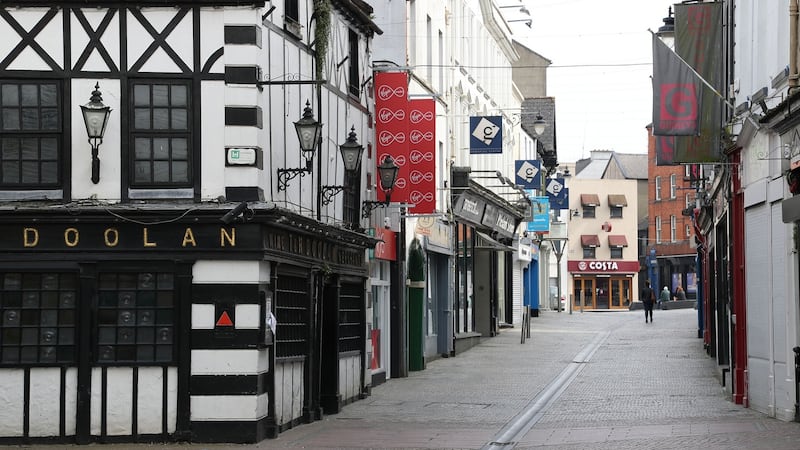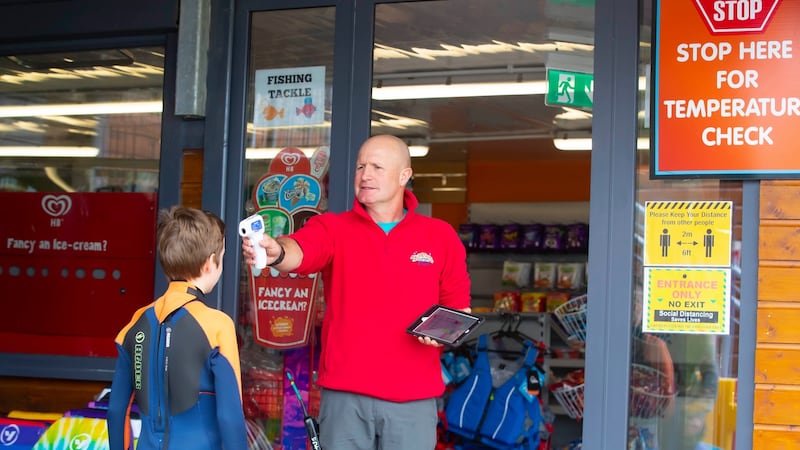It's midday on the last day before the Level 5 lockdown, and Michael Kelly is dejectedly surveying the empty floor space of his cafe, Grow HQ, in Waterford. On a normal weekday, the place would be heaving. "It's eerily quiet. It's heartbreaking to see it like this."
It’s been a while since there was anything like a normal weekday to compare it to. After the cafe reopened in July, Kelly rearranged the interior, moving retail to make more space for tables, and opened a food truck outside. When the restrictions moved to Level 3, he reduced capacity to 15 customers at a time outside. Now, he’s preparing for a return to takeaway only.
There are enough vegetables planted outside to supply several restaurants – they'll have to be sold through the weekly neighbourfood.ie virtual marketplace. Kelly supported the idea of regionalised restrictions, because he thought it "tapped into that intercounty competitiveness" in a positive way. Over the past couple of weeks, "you could see people here feeling confident that Waterford's numbers were low. Now they've taken that away. There's almost an air of, what's the point in being compliant if we're going to be treated the same as everyone else?"
Waterford – like every other part of Ireland – is being hammered by the second wave of Covid-19. There were 186 new coronavirus cases in the 14 days up to the beginning of the week – a huge number for a county that had only 138 cases up to the end of April.
'The only people that can protect Waterford's hospital are Waterford people; the only people that can protect Waterford's economy are Waterford people'
Still, per head of population, it held on to a record it has maintained throughout much of the pandemic, as the county with the lowest cumulative incidence of the virus, at 472 per 100,000. With 2.4 per cent of the country’s population, it accounts for 1 per cent of the cases.
"The whole of the southeast has remained in the bottom half of the table in terms of numbers of cases. That's evident from the numbers, and Waterford in particular has done very well. But it's important not to be complacent," says Dr Carmel Mullaney, who is director of public health for the HSE South East.

“Even in the counties with a very low incidence rate, that rate is only low relative to the other counties. They all had much lower rates even just a few weeks ago . . . Nothing has changed in relation to the basics of Covid. It’s spread from one person to another. You cannot relax. Spikes happen very fast.”
Waterford has direct experience of the speed at which spikes can take a population by surprise. During the 10 weeks between June 1st and August 11th, in a county of 116,000 people, there were only 14 new cases. The second half of August saw some slight daily increases.
But in September, a cluster at a meat plant and other, localised outbreaks – involving a post office, Communions and family parties – catapulted it from the bottom to the top of the table. By September 24th, Taoiseach Micheál Martin was warning of imminent tighter restrictions. But in the days that followed, Waterford pulled back from the precipice. By October 5th, it was back at the bottom of the 14-day incidence table, with a rate of 29.3 per 100,000.
Locally, says GP Sheenagh McNamara, “there was a sense that Covid was personal. We’re a city, but we’re small enough that it’s still personal. There was a sense that we need to step up and behave properly . . . that the only people that can protect Waterford’s hospital are Waterford people; the only people that can protect Waterford’s economy are Waterford people.”
The turnaround was also down to intense public health activity aimed at “controlling the outbreak in a specific setting. There was also a lot of effort, involving the local authority and the health services, around getting the message out to the population,” says Mullaney.
Even as things have deteriorated nationally, four out of the five counties at the bottom of the table – Carlow, Kilkenny, Waterford and Tipperary – are in the southeast. There is no scientific data to explain why this part of the country has, so far, been more effectively able to control the spread of the virus. But there are lots of hypotheses, and possibly even a few lessons.
Some of the theories cited locally include hard-to-replicate things: a dispersed, rural population; less concentrated housing; a well-planned public realm that lends itself to social distancing; ease of access to the coast and green spaces.
Many people cite the prevalence of the pharmaceutical industry, where employees are used to maintaining a high standard of hygiene, or the early announcement by Waterford Institute of Technology that all of its lectures would be moved online, meaning there was no late summer influx of students.
Part of the answer to Waterford's successful management of the virus almost certainly lies across the road from Grow HQ. Hospital manager Grace Rothwell touches wood when I ask her how University Hospital Waterford has navigated the crisis to date. "I'd say we're the only hospital in the country that hasn't had an outbreak so far," she says. "We've had no hospital-acquired infection for either patients or staff since March. It's not amazing at all. It's attributable to all that we do."
One of the hospital’s secret weapons is the Dunmore wing, the recently completed 72 single-room hospice section. At the start of the pandemic, only one floor was operational. “Over the course of 10 days, we staffed every single room in the place, including those private rooms. We cleared the house.” Haematology and oncology day wards were moved to UPMC private hospital, where they remain.
The other secret weapon is Rothwell, who is so determined to keep the virus out of the hospital, she appointed herself to a team of three that does all of their own contact tracing. The aim is that coronavirus patients are identified at the door of the emergency department, and diverted into the Covid pathway, where they wait out their test results in a single room on the Dunmore wing.
For those who come into the hospital through a different route, “we have to go right back and look to see when they came into the hospital, where they were all the different days. Today, for example, we have 44 people on the Covid pathway. Six are positive. Fourteen are awaiting swabs. The other 24 came from another healthcare facility.”
'People were doing the right thing straight away. Even when masks were only advised and not mandatory, a lot of people were wearing them'
They may not have symptoms or a history of close contact, “but to us they’re a risk factor. We do that to protect the patients, the staff and the community, and it has served us well.”
There was also a high degree of collaboration between consultants, hospital staff and GPs working in the community, says Dr Darach Brennan. "As GPs, we set up Zoom meetings and webinars to share resources and experiences of what's happening in the community and what's happening in the hospital. It really helped in terms problem-solving and agreeing alternate pathways for referrals."
There were no significant outbreaks in nursing homes either during the first wave, points out Danette Connolly, who is chairwoman of Waterford Hospice, president of Waterford Chamber and the national clinical lead for Home Instead Senior Care. "The nursing homes responded really rapidly in closing off to visitors," she says.

She also cites the same factor others do: a strong sense of community, good compliance, and collaboration between those working in healthcare in the community and the hospitals. “At one stage, our organisation was looking for PPE, and I was able to ring UPMC and ask for help with that.”
A large proportion of nursing-home staff are direct employees, so they’re not moving around as agency staff might be.
Public compliance is something else that comes up a lot when you talk to people about the southeast and coronavirus. Colin Jephson is a director of Ardkeen Quality Food Stores, the closest retail outlet to the hospital. He thinks a large part of Waterford's track record is accounted for by its smaller, more dispersed population and visible public compliance.
The store implemented mandatory hand sanitising and social distancing from early March, and there were few objectors. “People were doing the right thing straight away. Even when masks were only advised and not mandatory, a lot of people were wearing them,” he says.
Part of this may be attributable to the fact that the virus became real for people in Waterford early on, due to two high-profile cases. The first was in late January, when news broke of a suspected case at Waterford Institute of Technology: a student who had recently returned from Wuhan. In the event, the student was Covid-negative, but it felt like an early foreshadowing of what was to come.
Then, in early March, two brothers from the same family ended up on ventilators in intensive care, after one of them contracted the virus through his job in a factory. One, who is in his early 50s, spent 66 days in ICU. Their sister and her husband also got sick. None had underlying conditions.
'I'm worried again about the unknown. Will there be a big flu? Will the community transmission get to the stage that it will get completely out of hand, and we'll all be overrun'
All four recovered, and spoke publicly about their ordeals. Their courage in going public had a huge impact locally, says Brennan. “A lot of the talk at the time, which I didn’t like at all, involved references to elderly people or people with underlying medical conditions. This family were none of those things. And suddenly they were really sick. It became very real, very quickly. It was on your doorstep.”
Mullaney agrees with the view that “the local population in the southeast has really stood up to the plate and done its best to adhere to the restrictions. There are always exceptions, but most people have been really trying hard.”
There is a bit of concern locally, however, about whether that compliance can be sustained, or whether there is already evidence of slippage. McNamara says that “people took it very seriously here from the start here. They saw was because it wasn’t only their granny who might end up in ICU. It was healthy men in their 40s and 50s.”
But she has noticed a worrying degree of risk-taking creeping in recently. “A few weeks ago, people were isolating the minute they felt a bit sick. Now they’re on their third or fourth time having a child off school with a cold. And now maybe they’re waiting until they get a positive result and then isolating, instead of isolating as soon as they have symptoms.”
There is a feeling, she says, “that they’ve made all the sacrifices and they’ve seen no reward for them”.
Garvan Mulligan, an optician, pharmacist and a director of the Mulligan's chain of pharmacies in the southeast, has noticed the same trend – the compliance that sustained the city through seven months of the virus is beginning to strain.
“People aren’t restricting movements when they’re waiting for their tests results. They’re going along in their lives as though everything is normal. That’s not just in Waterford; that’s right across the country. People aren’t clear on the difference between ‘restrict your movements’ and ‘self-isolate’. When someone is waiting for results, or their children are waiting for results, they should be told to just stay at home.”
Better education and clearer communication is needed, he says.
Back at University Hospital Waterford, Rothwell is worried about how exhausted staff are now. “I’m worried again about the unknown. Will there be a big flu? Will the community transmission get to the stage that it will get completely out of hand, and we’ll all be overrun? The determination to keep our record” is weakening locally.
She’s also worried about some of the trends she’s seeing in transmission in recent weeks. Where are people picking up the virus? “It’s parties, family gatherings, and travel. What are people thinking having parties?”
Waterford’s enviable record is not only fragile, it’s cracking.





















